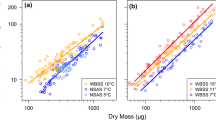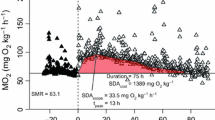Abstract
Multiple regression analysis was used to develop mathematical models applicable to the growth and food intake of Octopus vulgaris. The variables considered were: body weight (Bw: 175–3,500 g), temperature (T: 13–28 °C), sex (S: male = 0, female = 1) and diet (D: bogue fish = 0, crabs = 1). Growth and food intake may be succesfully expressed by means of the following equations: Ln (AGR + 14) = −2.0135 + 0.0895 Ln Bw + 0.5087 T − 0.0142 T2 + 0.2997 D (R2 = 71.79; ANOVA p < 0.0001) and Ln (AFR) = − 5.6577 + 0.5137 Ln Bw + 0.5266 T − 0.0132 T2 + 1.1135 D (R2 = 78.71; ANOVA p < 0.0001), where AGR: absolute growth rate, AFR: absolute feeding rate, Bw: body weight, T: temperature and D: diet. In our experimental conditions, sex did not affect growth or food intake. The optimum temperature for growth (17.5 °C) and food intake (20 °C) was independent of body weight. Growth and food intake were higher with the crab diet. Nevertheless, food efficiency was better for animals fed on fish (bogue). Maximum food efficiency was reached at 16.5 °C for both diets. When the temperature was above 23 °C, weight losses and mortality were recorded; the temperature at which this occurred depending on body weight and diet, so that smaller and bogue-fed individuals were more sensitive to increasing temperatures. O. vulgaris growth may provide optimum economic performance from 16 to 21 °C. This range is too narrow, considering the wide natural range (12–29 °C) in some Mediterranean areas. Therefore, O. vulgaris growth will be limited by seasonality of temperature or must be carried out with other systems (e.g. recirculation in closed systems with temperature control) for it to be economically viable.
Similar content being viewed by others
References
Aguado F., Rueda F.M., Egea M.A., Hernández M.D., Faraco F. and García García B. 2001. Efecto de la temperatura sobre la supervivencia en el transporte, estabulación y engorde de Octopus vulgaris Cuvier (1797) en el Mediterráneo occidental. In: Fernández-Palacios H. and Izquierdo M. (eds), Convergencia entre Investigación y Empresa: un reto para el siglo XXI. Serie Monografías del Instituto Canario de Ciencias Marinas. Vol. 4., Las Palmas de Gran Canaria, pp. 174–179.
Brett J.R. 1979. Environmental factors and growth. In: Hoar W.S., Randall D.J. and Brett J.R. (eds), Fish Physiology, Bioenergetics and Growth. Vol. 8. Academic Press, New York, pp. 599–675.
Buckel J.A., Steinberg N.D. and Conover D.O. 1995. Effects of temperature, salinity, and fish size on growth and consumption of juvenile bluefish. Journal of Fish Biology 47: 696–706.
Cagnetta P. and Sublimi A. 1999. Productive performance on the common octopus (Octopus vulgaris C.) when fed on a monodiet. Seminar on Mediterranean Marine aquaculture finfish species diversification. CIHEAM - IAMZ and FAO, Zaragoza, Spain, pp. 1–3.
Castro B.G., DiMarco F.P., DeRusha R.H. and Lee P.G. 1993. The effects of surimi and pelleted diets on the laboratory survival, growth and feeding rate of the cuttlefish Sepia offıcinalis L. Journal of Experimental Marine Biology and Ecology 170: 241–252.
Cortez T., Castro B.G. and Guerra A. 1995a. Feeding dynamics of Octopus mimus (Mollusca: Cephalopoda) in northern Chile waters. Marine Biology 123: 497–503.
Cortez T., Castro B.G. and Guerra A. 1995b. Reproduction and condition of female Octopus mimus (Mollusca: Cephalopoda). Marine Biology 123: 505–510.
DeRusha R.H., Forsythe J.W., DiMarco F.P. and Hanlon R.T. 1989. Alternative diets for maintaining and rearing cephalopods in captivity. Laboratory Animal Science 39: 306–312.
Elliott J.M. 1975. The growth rate of brown trout (Salmo trutta L.) fed on maximun rations. Journal of Animal Ecology 44: 805–821.
Fonds M., Cronie R., Vethaak A.D. and van der Puyl P. 1992. Metabolism, food consumption and growth of plaice (Pleuronectes platessa) and flounder (Platichthys flesus) in relation to fish size and temperature. Netherland Journal of Sea Research 29: 127–143.
Forsythe J.W. and Van Heukelem W.F. 1987. Growth. In: Boyle P.R. (ed.), Cephalopod Life Cycles. Vol. 2. Academic Press, London, pp. 135–155.
Forsythe J.W. and Hanlon R.T. 1988. Effect of temperature on laboratory growth, reproduction and life span of Octopus bimaculoides. Marine Biology 98: 369–379.
García García B. 1994. Factores que influyen sobre el consumo de oxígeno, ingesta y crecimiento en la dorada (Sparus aurata, L.): una aproximación al establecimiento de modelos lineales. PhD Dissertation, University of Murcia, Spain.
García García B. and Aguado Giménez F. 2002. Influence of diet on ongrowing and nutrient utilization in the common octopus (Octopus vulgaris). Aquaculture 211: 173–184.
Guerra A. 1978. Sobre la alimentación y el comportamiento alimentario de Octopus vulgaris. Investigaciones Pesqueras 42: 351–364.
Guerra A. and Nixon M. 1987. Crab and mollusc shell drilling by Octopus vulgaris (Mollusca: Cephalopoda) in the Ria de Vigo (north-wet Spain). Journal Zoological of London 211: 515–523.
Hanlon R.T. and Messenger J.B. 1996. Cephalopod Behaviour. Cambridge University Press, Cambridge.
Iglesias J., Sánchez F.J. and Otero J.J. 1997. Primeras experiencias sobre el cultivo integral del pulpo (Octopus vulgaris, Cuvier) en el Instituto Español de Oceanografía. In: Costa J., Abellán E., García García B., Ortega A. and Zamora S. (eds), VI Congreso Nacional de Acuicultura., Cartagena, Spain, pp. 221–226.
Imsland A.K., Sunde L.M., Folkvord A. and Stefanssons S.O. 1996. The interaction of temperature and fish size of juvenile turbot. Journal of Fish Biology 49: 926–940.
Jobling M. 1994. Fish Bioenergetics. Chapman and Hall, London.
Jonassen T.M., Imsland A.K. and Stefansson S.O. 1999. The interaction of temperature and fish size on growth of juvenile halibut. Journal of Fish Biology 54: 556–572.
Koskela J., Pirhonen J. and Jobling M. 1997. Feed intake, growth rate and body composition of juvenile Baltic salmon exposed to different constant temperatures. Aquaculture International 5: 351–360.
Lee P.G., Forsythe J.W., DiMarco F.P., DeRusha R.H. and Hanlon R.T. 1991. Initial palatability and growth trials on pelleted diets for cephalopods. Bulletin of Marine Science 49: 362–372.
Lee P.G. 1994. Nutrition of cephalopods: Fueling the system. In: Pörtner H.O., O'Dor R.K. and Macmillan D.L. (eds), Physiology of Cephalopod Molluscs: Lifestyle and Performance Adaptations. Gordon & Brench Publishers, Switzerland, pp. 35–51.
Liu J. and Cui Y. 1998. Food consumption and growth of two piscivorous fishes, the mandarin fish and chinese snakehead. Journal of Fish Biology 53: 1071–1073.
Luaces M. and Rey M. 1999. El engorde industrial de pulpo (Octopus vulgaris) en jaulas: análisis de dos años de cultivo en la Ría de Camariñas (Galicia). Actas del VII Congreso Nacional de Acuicultura., Las Palmas de Gran Canaria, Spain, pp 46.
Lupatsch I. and Kissil G.W. 1998. Predicting aquaculture waste from gilthead seabream (Sparus aurata) culture using a nutritional approach. Aquatic Living Resources 1: 195–204.
Mangold K. 1963. Biologie des Céphalopodes bentiques et nectoniques de la Mer Catalane. Vie et Milieu: 1–33.
Mangold K. 1983. Food, feeding and growth in cephalopods. Memoirs of the National Museum of Victoria 44: 81–93.
Miglavs I. and Jobling M. 1989. The effects of feeding regime on proximate body composition and patterns of energy deposition in juvenile artic charr, Salvelinus alpinus. Journal of Fish Biology 35: 1–11.
Nigmatulin C.M. and Ostapenko A.A. 1976. Feeding of Octopus vulgaris Lam. From the Northwest African coasts. ICES Comm. Meet (Shellfish Benthos Comm) K 6: 1–13.
Nixon M. 1966. Changes in body weight and intake of food by Octopus vulgaris. Journal Zoological of London 150: 1–9.
O'Dor R.K. and Wells M.J. 1978. Reproduction versus somatic growth: hormonal control in Octopus vulgaris. Journal of Experimental Biology 77: 529–540.
O'Dor R.K., Mangold K., Boucher-Rodoni R., Wells M.J. and Wells J. 1983. Nutrient Absorption, Storage and Remobilization in Octopus vulgaris. Marine Behavior and Physiology 11: 239–258.
Pedersen T. and Jobling M. 1989. Growth rates of large, sexually mature cod, Gadus morhua, in relation to condition and temperature during an annual cycle. Aquaculture 81: 161–168.
Petridis D. and Rogdakis I. 1996. The development of growth and feeding equation for sea bream, Sparus aurata L., culture. Aquaculture Research 27: 413–419.
Rodríguez C. and Carrasco J.F. 1999. Engorde de pulpo (Octopus vulgaris Cuvier). Resultados de crecimiento, supervivencia y reproducción. Actas del VII Congreso Nacional de Acuicultura., Las Palmas de Gran Canaria, Spain.
Smale M.J. and Buchan P.R. 1981. Biology of Octopus vulgaris off the East coast of South Africa. Marine Biology 65: 1–12.
Wells M.J. and Wells J. 1959. Hormonal control of sexual maturity in Octopus. Journal of Experimental Biology 36: 1–33.
Wells M.J., O'dor R.K., Mangold K. and Wells J. 1983. Diurnal changes in activity and metabolic rate in Octopus vulgaris. Marine Behavior and Physiology 9: 275–287.
Wooton R.J., Allen J.R.M. and Cole S.J. 1980. Effect of body weight and temperature on the maximum daily food consumption of Gasterosteus aculeatus (L.) and Phoxinus phoxinus (L.): selecting an appropiate model. Journal of Fish Biology 17: 695–705.
Author information
Authors and Affiliations
Rights and permissions
About this article
Cite this article
Aguado Giménez, F., García García, B. Growth and food intake models in Octopus vulgaris Cuvier (1797): influence of body weight, temperature, sex and diet. Aquaculture International 10, 361–377 (2002). https://doi.org/10.1023/A:1023335024053
Issue Date:
DOI: https://doi.org/10.1023/A:1023335024053




